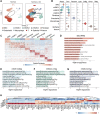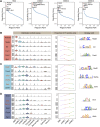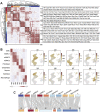Revealing the Critical Regulators of Modulated Smooth Muscle Cells in Atherosclerosis in Mice
- PMID: 35677564
- PMCID: PMC9168464
- DOI: 10.3389/fgene.2022.900358
Revealing the Critical Regulators of Modulated Smooth Muscle Cells in Atherosclerosis in Mice
Abstract
Background: There are still residual risks for atherosclerosis (AS)-associated cardiovascular diseases to be resolved. Considering the vital role of phenotypic switching of smooth muscle cells (SMCs) in AS, especially in calcification, targeting SMC phenotypic modulation holds great promise for clinical implications. Methods: To perform an unbiased and systematic analysis of the molecular regulatory mechanism of phenotypic switching of SMCs during AS in mice, we searched and included several publicly available single-cell datasets from the GEO database, resulting in an inclusion of more than 80,000 cells. Algorithms implemented in the Seurat package were used for cell clustering and cell atlas depiction. The pySCENIC and SCENIC packages were used to identify master regulators of interested cell groups. Monocle2 was used to perform pseudotime analysis. clusterProfiler was used for Gene Ontology enrichment analysis. Results: After dimensionality reduction and clustering, reliable annotation was performed. Comparative analysis between cells from normal artery and AS lesions revealed that three clusters emerged as AS progression, designated as mSMC1, mSMC2, and mSMC3. Transcriptional and functional enrichment analysis established a continuous transitional mode of SMCs' transdifferentiation to mSMCs, which is further supported by pseudotime analysis. A total of 237 regulons were identified with varying activity scores across cell types. A potential core regulatory network was constructed for SMC and mSMC subtypes. In addition, module analysis revealed a coordinate regulatory mode of regulons for a specific cell type. Intriguingly, consistent with gain of ossification-related transcriptional and functional characteristics, a corresponding small set of regulators contributing to osteochondral reprogramming was identified in mSMC3, including Dlx5, Sox9, and Runx2. Conclusion: Gene regulatory network inference indicates a hierarchical organization of regulatory modules that work together in fine-tuning cellular states. The analysis here provides a valuable resource that can provide guidance for subsequent biological experiments.
Keywords: atherosclerosis; gene regulatory network; phenotypic modulation; single-cell RNA sequencing; smooth muscle cells.
Copyright © 2022 Zhou, Bai, Chen, Li, Zhang and Liu.
Conflict of interest statement
The authors declare that the research was conducted in the absence of any commercial or financial relationships that could be construed as a potential conflict of interest.
Figures



Similar articles
-
Single-Cell Genomics Reveals a Novel Cell State During Smooth Muscle Cell Phenotypic Switching and Potential Therapeutic Targets for Atherosclerosis in Mouse and Human.Circulation. 2020 Nov 24;142(21):2060-2075. doi: 10.1161/CIRCULATIONAHA.120.048378. Epub 2020 Sep 23. Circulation. 2020. PMID: 32962412 Free PMC article.
-
Environment-Sensing Aryl Hydrocarbon Receptor Inhibits the Chondrogenic Fate of Modulated Smooth Muscle Cells in Atherosclerotic Lesions.Circulation. 2020 Aug 11;142(6):575-590. doi: 10.1161/CIRCULATIONAHA.120.045981. Epub 2020 May 22. Circulation. 2020. PMID: 32441123 Free PMC article.
-
Inference of Gene Regulatory Network from Single-Cell Transcriptomic Data Using pySCENIC.Methods Mol Biol. 2021;2328:171-182. doi: 10.1007/978-1-0716-1534-8_10. Methods Mol Biol. 2021. PMID: 34251625
-
Smooth muscle cell phenotypic switching in atherosclerosis.Cardiovasc Res. 2012 Jul 15;95(2):156-64. doi: 10.1093/cvr/cvs115. Epub 2012 Mar 8. Cardiovasc Res. 2012. PMID: 22406749 Free PMC article. Review.
-
Molecular control of vascular smooth muscle cell differentiation and phenotypic plasticity.Novartis Found Symp. 2007;283:174-91; discussion 191-3, 238-41. doi: 10.1002/9780470319413.ch14. Novartis Found Symp. 2007. PMID: 18300422 Review.
Cited by
-
Integration of single-cell and bulk RNA-seq to establish a predictive signature based on the differentiation trajectory of M2 macrophages in lung adenocarcinoma.Front Genet. 2022 Sep 12;13:1010440. doi: 10.3389/fgene.2022.1010440. eCollection 2022. Front Genet. 2022. PMID: 36171876 Free PMC article.
-
Spatial multiomics atlas reveals smooth muscle phenotypic transformation and metabolic reprogramming in diabetic macroangiopathy.Cardiovasc Diabetol. 2024 Oct 12;23(1):358. doi: 10.1186/s12933-024-02458-x. Cardiovasc Diabetol. 2024. PMID: 39395983 Free PMC article.
-
Gene inactivation of lysyl oxidase in smooth muscle cells reduces atherosclerosis burden and plaque calcification in hyperlipidemic mice.Atherosclerosis. 2024 Oct;397:118582. doi: 10.1016/j.atherosclerosis.2024.118582. Epub 2024 Aug 31. Atherosclerosis. 2024. PMID: 39260002
-
Mechanisms modulating foam cell formation in the arterial intima: exploring new therapeutic opportunities in atherosclerosis.Front Cardiovasc Med. 2024 Jun 17;11:1381520. doi: 10.3389/fcvm.2024.1381520. eCollection 2024. Front Cardiovasc Med. 2024. PMID: 38952543 Free PMC article. Review.
-
Aggrephagy-related patterns in tumor microenvironment, prognosis, and immunotherapy for acute myeloid leukemia: a comprehensive single-cell RNA sequencing analysis.Front Oncol. 2023 Jul 17;13:1195392. doi: 10.3389/fonc.2023.1195392. eCollection 2023. Front Oncol. 2023. PMID: 37534253 Free PMC article.
References
-
- Alencar G. F., Owsiany K. M., Karnewar S., Sukhavasi K., Mocci G., Nguyen A. T., et al. (2020). Stem Cell Pluripotency Genes Klf4 and Oct4 Regulate Complex SMC Phenotypic Changes Critical in Late-Stage Atherosclerotic Lesion Pathogenesis. Circulation 142, 2045–2059. 10.1161/CIRCULATIONAHA.120.046672 - DOI - PMC - PubMed
-
- Almontashiri N. A. M., Antoine D., Zhou X., Vilmundarson R. O., Zhang S. X., Hao K. N., et al. (2120). 9p21.3 Coronary Artery Disease Risk Variants Disrupt TEAD Transcription Factor-dependent Transforming Growth Factor β Regulation of P16 Expression in Human Aortic Smooth Muscle Cells. Circulation 132, 1969–1978. 10.1161/CIRCULATIONAHA.114.015023 - DOI - PubMed
LinkOut - more resources
Full Text Sources
Research Materials

